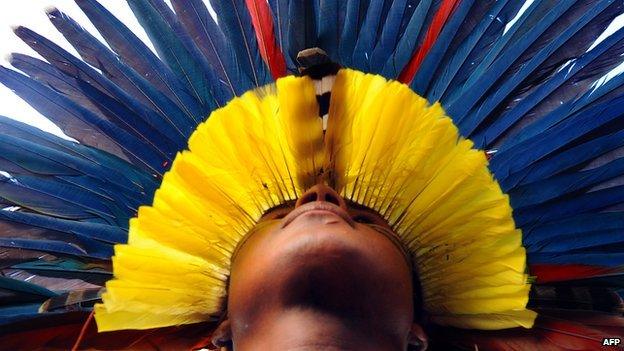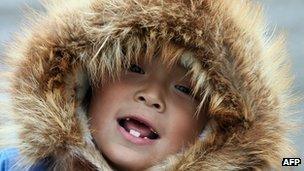Americas 'settled in three waves'
- Published

Most indigenous Americans are descended from a single group of migrants, but later waves of people made important contributions
The biggest survey of Native American DNA has concluded that the New World was settled in three major waves.
But the majority of today's indigenous Americans descend from a single group of migrants that crossed from Asia to Alaska 15,000 years ago or more.
Previous genetic data have lent support to the idea that America was colonised by a single migrant wave.
An international team of researchers have published their findings in the journal Nature.
"For years it has been contentious whether the settlement of the Americas occurred by means of a single or multiple migrations from Siberia," said co-author Prof Andres Ruiz-Linares from University College London (UCL).
"But our research settles this debate: Native Americans do not stem from a single migration. Our study also begins to cast light on patterns of human dispersal within the Americas."
The team analysed data from 52 Native American and 17 Siberian groups, studying more than 300,000 variations in their DNA known as Single Nucleotide Polymorphisms, or SNPs.
This allowed them to examine patterns of genetic similarities and differences between the population groups.
Later waves
The second and third migrations have left an impact only in Arctic populations whose languages belong to the Eskimo-Aleut family and in the Canadian Chipewyan who speak a language that belongs to the Na-Dene family.
However, even these populations have inherited most of their genome (the DNA sequence contained in the nuclei of cells) from the earliest migration.

The second and third waves left their mark mainly in populations living in the Arctic
Eskimo-Aleut speakers derive more than 50% of their DNA from what the researchers call "First Americans", and the Chipewyan around 90%. This reflects the fact that the two later streams of migration from Asia mixed with the populations descended from the first wave.
"There are at least three deep lineages in Native American populations," said co-author David Reich, professor of genetics at Harvard Medical School.
"The Asian lineage leading to First Americans is the most anciently diverged, whereas the Asian lineages that contributed some of the DNA to Eskimo-Aleut speakers and the Na-Dene-speaking Chipewyan from Canada are more closely related to present-day East Asian populations."
Evidence from mitochondrial DNA (mtDNA), the genetic information in the mitochondria that power cells, supports descent from a single founding group of colonisers, who crossed from Siberia into America across the Bering land bridge.
This natural bridge appeared during the last Ice Age when sea levels were lower, allowing hunters to trek between the two continents.

But a three-stage migration has been proposed before, based on a controversial interpretation of language relationships and physical features of the teeth of Native American groups.
The team also found that once in the Americas, people expanded southward along a route that hugged the coast, with populations splitting off along the way.
After their divergence, there was little gene flow among Native American groups, especially in South America.
Two glaring exceptions to this simple dispersal were also discovered. First, Central American Chibchan-speakers have ancestry from both North and South America, reflecting a migration back from South America to Central America.
Second, the Naukan and coastal Chukchi from north-eastern Siberia carry distinctive "First American" DNA. Thus, Eskimo-Aleut speakers migrated back to Asia, bringing Native American genes.
The team's analysis was complicated by the influx into the hemisphere of European and African immigrants since 1492 and the 500 years of genetic mixing that followed.
To address this, the authors developed methods that allowed them to focus on the sections of peoples' genomes that were of entirely Native American origin.
- Published24 March 2011
- Published4 March 2011
- Published21 October 2011